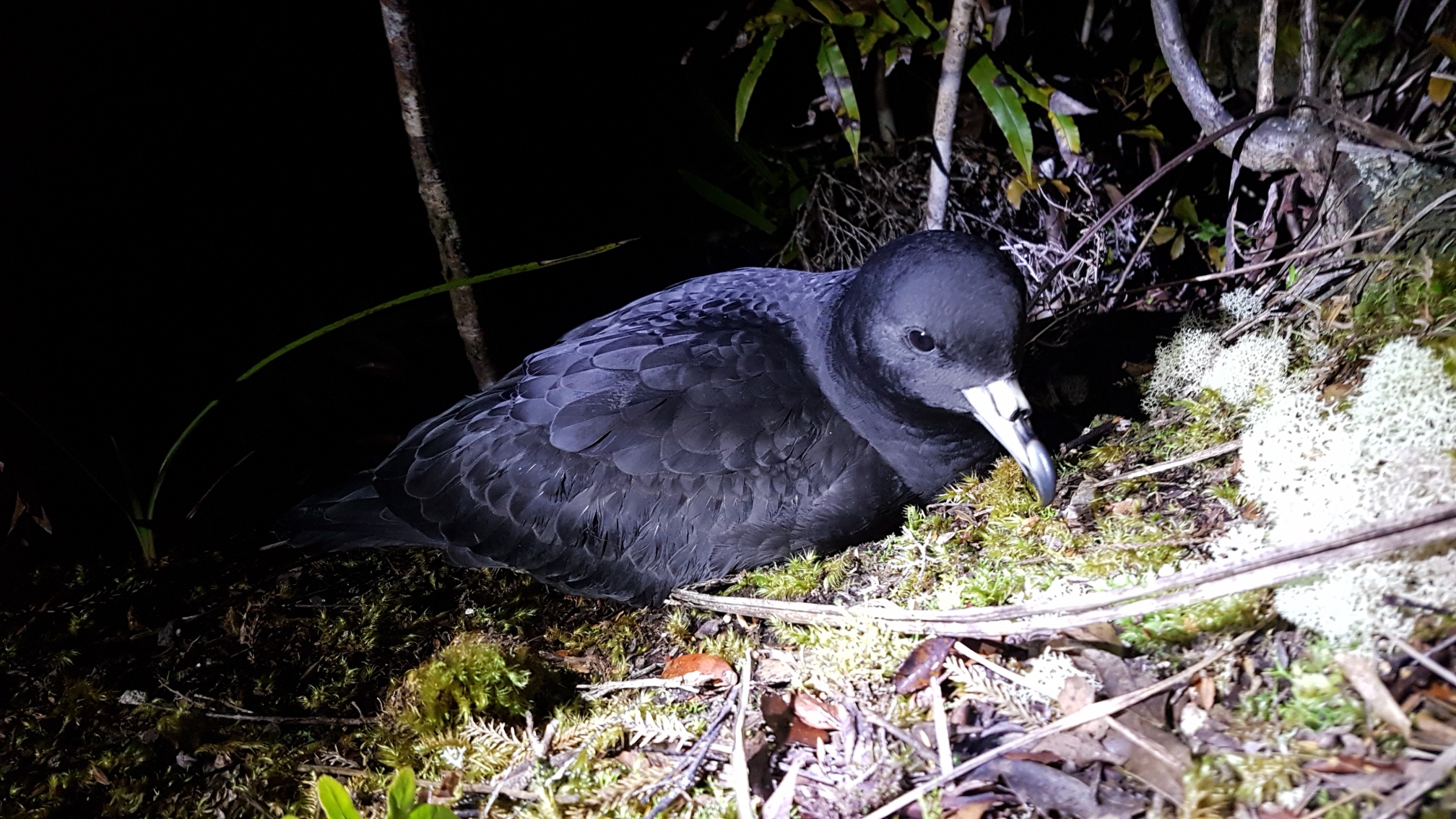 A fledgling Black Petrel; photograph by Elizabeth (Biz) Bell, WMIL
A fledgling Black Petrel; photograph by Elizabeth (Biz) Bell, WMIL
A report by Elizabeth Bell (Wildlife Management International Ltd, New Zealand) and colleagues on the tākoketai/Black Petrel, Procellaria parkinsoni of Aotea/Great Barrier Island has been released by New Zealand’s Department of Conservation (NZDOC). Research for the report, Key demographic parameters and population trends of black petrels (Procellaria parkinsoni) – 2022/23, was carried out over the 2022/2023 breeding season.
The summary from the NZDOC website follows:
"During the 2022/23 breeding season 480 tākoketai/black petrel study burrows were intensively monitored within the Mt Hobson/Hirakimata study area on Aotea/Great Barrier Island.
There were 313 (65.2%) burrows occupied by breeding pairs, 64 (13.3%) occupied by non-breeding birds, and 103 (21.5%) were unoccupied. Overall, 191 chicks were produced from the study burrows representing a fledgling success rate of 61%, but 13 chicks were found to be below weight and smaller in size during the May chick banding trip, and most of these chicks were not expected to survive to fledging. This would further reduce breeding success to 56.9%.
Breeding success was impacted by weather events, specifically the Auckland flood event on 27 January 2023 and Cyclone Gabrielle between 12-16 February 2023. A number of burrows flooded, causing eggs to fail and small chicks to drown or chill and die, and foraging success of parents appeared to be reduced with 13 chicks being in poor condition by May prior to fledging.
Nine census grids were monitored within the study area and accounted for 197 of the inspected study burrows. Of these, 119 were occupied by breeding pairs (60.4%) and 68 chicks were produced representing a fledging success rate of 57.1%. Again 7 of these chicks were in poor condition and were not expected to fledge, reducing breeding success to 52.1%.
A total of 664 adults and 129 fledgling chicks were captured during the 2022/23 field season with 174 adults banded this season (including 52 from study burrows). Of the 129 fledgling chicks banded during the 2022/23 field season, 119 were banded in study burrows; 72 could not be banded due to torrential rain over the chick banding trip, and one had already fledged prior to the banding visit in May 2023.
There have been a total of 420 returned chicks recaptured at the colony since they were banded prior to fledging. Of these, 117 returned chicks were identified during the 2022/23 breeding season; 28 of which were caught for the first time at the colony. The majority of all 420 returned chicks were from the 2016/17 breeding season, followed by the 2013/14 cohort. Not all cohorts were represented as no returned chicks from the 1995/96, 1996/97 and 1997/98 cohorts were recaptured this season. Understanding the factors affecting return rates of chicks within the 35-ha study site is vital. It is important to determine whether it is related to low juvenile survival and/or recruitment or if it is simply due to a lack of detection. Understanding juvenile survival and recruitment is necessary for accurate demographic modelling and for species risk assessment modelling. Therefore, it is recommended that effort to obtain this data is completed with urgency.
Additional monitoring of pig and other predator occurrence and impact on black petrels on Cooper’s Castle was undertaken this season. Eighteen black petrel burrows were identified within the boundaries of this study area; three were breeding sites and four sites were being visited by non- breeding birds. All other burrows were empty. Trail cameras were placed along pig pathways, walking tracks and outside active black petrel burrows. Footage confirmed feral pig, rat, and feral cat presence. While no interactions with black petrels were caught on camera at Cooper’s Castle, there was one cat predation of an unbanded adult and one chick from a random, non-monitored burrow. There was one rat predation event at the study colony on Hirakimata this season. Introduced species still pose a threat to the black petrel population and it is imperative pest control measures continue."
Reference:
Bell, E.A., Lamb, S. & Maclean, C. 2023. Key demographic parameters and population trends of tākoketai/black petrels (Procellaria parkinsoni) on Aotea/Great Barrier Island: 2022/23. POP2022-01 final report prepared by Wildlife Management International Ltd for the Conservation Services Programme, Department of Conservation, Wellington. 41 p.
07 September 2023

 English
English  Français
Français  Español
Español